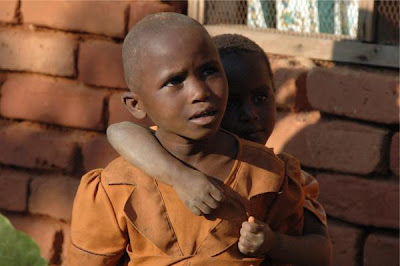The village of Ilambilole in Tanzania Africa was waiting for the arrival of the visitors. The singers and children were in their places ready to greet them and lead them to the first of three meeting places.
The visitors arrived a couple of hours late but that does not matter to the villagers. They will wait until you come. I later find out that it is not unusual to wait for someone to show up but my DNA says do not be late for an appointment. We could not have arrived earlier because of the travel delays. I was hoping that the village would not be disappointed with our tardiness and depart. And no, they did not leave. They were waiting patiently for the arrival.
The vehicles turn onto the main road of the village and the people start the dancing and singing and as the vehicles get closer you can hear the welcoming song. The vehicles stop and the people step out in front and lead them to the first meeting place. Slowly we proceed behind the group singing and dancing down the street.
We arrive at the location a few minutes later as the crowd surrounds the vehicles singing and dancing. The visitors get out of the vehicles and some of us are overcome to the point of tears by the welcome and the feeling of being unworthy of such a welcome. We had just come to attend some meetings and see the village – not anything special in our own eyes. We did not know the culture or the importance of the moment for the village.
The walk to the town center is about two of our city blocks in length but before we start the adults and children line up in two rows single file in front of the visitors and leaders. The villagers start the procession singing and walking in a slow rhythm to the city center. I asked myself why are they doing this? – not knowing the importance of this occasion. I am going along and very impressed but still have no idea the importance but I am soon to find out.
When we arrive at the town center it looks like the whole village has arrived. Several hundred people are there waiting to hear from the leader of the visitors group – a man that has been in the village many times and is the reason this is such an important meeting time today. Almost all of the villagers are singing and many are dancing as we prepare for the meeting. Chairs are lined up for the leaders of the village and the seats of honor are for the visitors. The singing and dancing slowly subsides as the meeting is about to start.
The community leader, the pastor, starts the introductions. All of the leaders of the village and surrounding area are introduced and then the visitors have their opportunity to introduce themselves. Our leader, Ray Menard, stands to introduce the visitors. There are two doctors, an elder from a church in the USA and me a business man. Each of us has an opportunity to share and express our gratitude for the warm welcome of the village. The meeting continues for a couple of hours and then it is time to separate from the villagers and meet with just the leaders at the church.
The village meeting has ended and we are headed to the church for the leaders meeting. The singing starts again and the children run to the visitors to escort them to the church. There is a child on each hand and other holding their hand stretching across the road all singing along the way. We arrive at the church and the children instantly fill half of the room. The children gather for the next meeting. But they are not the leaders so they will have to go. But before they go they perform a song for us all and then they are escorted out. The singing outside the church continues as we start the meeting. There is not much day time left and this village has no electricity. So it is going to be a short meeting so everyone can get home before dark, I thought. That was a bad assumption because there was a small fluorescent light on a battery that hung over the table at the center of the room where Ray, an interpreter and the pastor sat. The remaining the visitors were in seats of honor up front. The meeting went on for a couple of hours and it is dark inside and out except for the small light that is shining on the center table of the three men.
The meeting ends and we go to the home of the pastor which has been built with some extra rooms for visitors to come and stay. We arrive at the home for our dinner and bed after all of the hand-shaking and visiting but there is more to come unbeknown to us.
The ladies had been cooking for several hours to prepare the meal and it was delicious. A couple of the visitors thought it was time to go to bed but there was another event that was about to take place. The ceremony of the Three Cakes. The living room area was cleared of dishes after the meal and people gathered around the room. The room is about 12 x 15 with some big furniture and a coffee table. There are about 20 villagers attending this ceremony. This Mzungu (White Man) did not know what was about to take place.
Cake is not a regular item on the menu in fact it is only made on very special occasions. This was one of those occasions designated by the village. The Three Cakes were made to demonstrate the unity between the village and a person or group on a very special occasion. The leader of the visitors, Ray, the heart of our organization is the person being honored with the ceremony because of the respect and love that the villagers have developed for him.
Each cake is about a 10” round yellow wheat flour cake. Wheat flour is one ingredient that is not readily available. The ceremony starts as the ladies’ leader comes into the room carrying all three cakes. She slowly makes her way to the coffee table as she moves to the singing of the villagers. She slowly bends at the knees and sets the platter of cakes on the table and the singing gets softer and softer until it stops. The three cakes are now on the end of the coffee table in front of Ray. The lady explains about the procedures for the three cake ceremony. Cake number one is for Ray to break into pieces and give every villager that is attending a piece. This is to show the willingness to join with the village in all endeavors. The second cake is taken by the pastor and divided among the visitors to show the unity between the village and the visitors. Ray and the pastor take the third cake together each breaking off a piece and feed it to the other person, similar to our wedding ceremony; this demonstrates the unity in thought between the leaders of both groups. The ceremony ends with singing, laughing, and lots of hugging and tears of joy.
The whole day was quite an experience and one that will not be forgotten and as we say in America “that takes the cake.”





















































